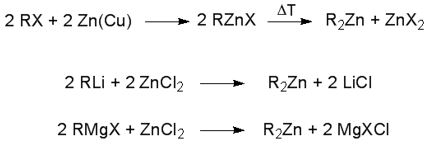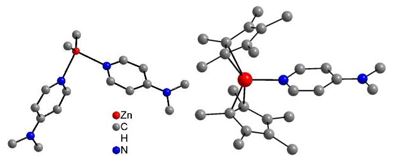Organometallic complexes of group 12 metals (Zn)
E. Frankland attempts in 1849 to prepare free ethyl radicals by the reaction of EtI with elemental zinc yielded diethylzinc Et2Zn, the first organozinc complex. This synthetic route, which is called direct synthesis, still is a very simple and effective method for the synthesis of organozinc compounds. Alternative synthesis methods are salt elimination and metathesis reactions [1].
Organozinc compounds are usually volatile compounds with relatively low boiling and melting points (ZnEt2: Smp. = -28 °C, Sdp. = 118 °C). They typically adopt monomeric structures and show a linear structure. However, ZnMe2 shows weak intermolecular Zn···Me contacts in the solid state.[2] They react as Lewis acids, but their Lewis acidity is significantly lower compared to aluminum organyls. With Lewis bases, they preferentially form tetrahedral complexes. Moreover, zinc organyls are typical alkyl transfer reagents, which are less reactive but more selective then their aluminum congeners and therefore widely applied in organic chemistry. Their reactivity can also be tuned (cuprates) [3].
References
[1] C. Elschenbroich, Organometallchemie, Teubner Verlag, Wiesbaden, 2005.
[2] Bacsa, J.; Hanke, F.; Hindley, S.; Odedra, R.; Darling, G. R.; Jones, A. C.; Steiner A. Angew. Chem. Int. Ed. 2011, 50, 11685.
[3] N. Krause, Metallorganische Chemie, Spektrum Akademischer Verlag, Heidelberg, 1996.
[4] a) F. Thomas, S. Schulz, M. Nieger, Angew. Chem. 2005, 117, 5813; b) D. Schuchmann, U. Westphal, S. Schulz, U. Flörke, D. Bläser, R. Boese, Angew. Chem. 2009, 121, 821.
Go back: Organometallic Chemistry
For more: Organometallic complexes of group 13 metals (Al - Tl)


